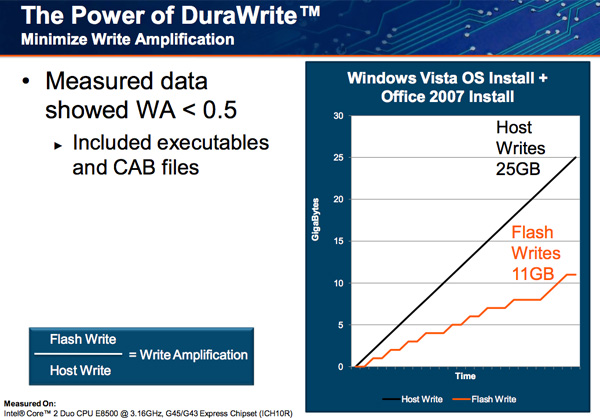SandForce Announces Next-Gen SSDs, SF-2000 Capable of 500MB/s and 60K IOPS
by Anand Lal Shimpi on October 7, 2010 9:30 AM ESTFor months SandForce has been telling me that the market is really going to get exciting once its next-generation controller is ready. I didn’t really believe it, simply because that’s what every company tells me. But in this case, at least based on what SandForce showed me, I probably should have.
What we have today are the official specs of the second-generation SandForce SSDs, the SF-2000 series. Drives will be sampling to enterprise customers in the coming weeks, but we probably won’t see shipping hardware until Q1 2011 if everything goes according to plan. And the specs are astounding:

We'll get to the how in a moment, but let's start at the basics. The overall architecture of the SF-2000 remains unchanged from what we have today with the SF-1200/SF-1500 controllers.
SandForce’s controller gets around the inherent problems with writing to NAND by simply writing less. Using real time compression and data deduplication algorithms, the SF controllers store a representation of your data and not the actual data itself. The reduced data stored on the drive is also encrypted and stored redundantly across the NAND to guarantee against dataloss from page level or block level failures. Both of these features are made possible by the fact that there’s simply less data to manage.

Another side effect of SandForce’s write-less policy is there’s no need for an external DRAM to handle large mapping tables. It reduces the total BOM cost of the SSD and allows SandForce to charge a premium for its controllers.

These are the basics and as I mentioned above, they haven’t changed. The new SF-2000 controller is faster but the fundamental algorithms remain the same. The three areas that have been improved however are the NAND interface, the on-chip memories, and the encryption engine.










84 Comments
View All Comments
ibudic1 - Thursday, October 7, 2010 - link
Intel will be slower, but I bet it will be more reliable.Intel will also be able to offer twice the storage for the same amount 22nm vs 32 nm.
So high stable performance and twice the area, vs fast and small. So far all of this is vaporware.
Nihility - Thursday, October 7, 2010 - link
I wouldn't call the Intel product vaporware. It's almost guaranteed that they'll ship them on time.ggathagan - Friday, October 8, 2010 - link
I believe ibudic1 was referring to the Sandforce controller as vaporware, not Intel's product.sbrown23 - Thursday, October 7, 2010 - link
You mean 25nm vs 34nm? And Intel products are generally not vaporware. They have a fairly good record of delivery. This isn't Duke Nukem Forever, here.anindividual - Thursday, October 7, 2010 - link
http://www.plianttechnology.com/They have had an enterprise drive line with a proprietary controller on the market for over a year with much of this capability.
bji - Thursday, October 7, 2010 - link
That link indicates that the company in question is using SLC flash in their drives. This is guaranteed to put them out of the same price range as the Intel and Sandforce MLC drives, the latter already being expensive enough to be seriously limited in their market uptake. Conclusion: almost nobody is buying the Pliant Technology drives because they are too expensive compared to other options.mino - Thursday, October 7, 2010 - link
Nobody is willing to go for MLC in REAL enterprise drives.X25-E and the Sandforce stuff is mostly good for HPC and lower mid-range, but mostly DAS setups.
The EMC's of this world use far more robust (and far more pricey) solutions.
nexox - Thursday, October 7, 2010 - link
"""X25-E and the Sandforce stuff is mostly good for HPC and lower mid-range, but mostly DAS setups."""X25-E is an SLC drive. The X25-M is MLC.
"""Nobody is willing to go for MLC in REAL enterprise drives."""
You'll find that vendors are not targeting MLC at enterprises, but rather eMLC, which is somewhat different.
And you'd be wrong about enterprises wanting to avoid eMLC drives. They (will) serve pretty well for many work loads, in places where SLC is cost prohibitive, and spinning disks are too slow.
Casper42 - Friday, October 8, 2010 - link
"Nobody is willing to go for MLC in REAL enterprise drives" ????I work for HP in the Server division and all I can legally tell you is your WRONG.
PS: Ever heard of a slow little drive called the ioDrive Duo? The 640GB model uses MLC. I recently sold 3 of these to a Global 100 company that plans to run a SQL based Data Mining app on them.
HachavBanav - Friday, October 8, 2010 - link
Pliant "LB 150S" = 150GB (2.5" + SLC + SAS dual port ) for $4500 !@anindividual : please ask your boss to review the price, this is just non-sense !